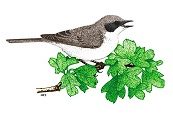Thirteen tree-lovers gathered at Jenny’s Well on a pleasant, if chilly, Sunday afternoon on 18th February, for a spot of winter tree identifying. We were accompanied by Matt and May, from the Friends of Jenny’s Well, who were doing a litter pick round the site. Kirsty, who led the walk, helped by Judy, had previously done a couple of recces on the reserve to ensure that our circuit would include a good variety of species. We were fortunate to also have Simon as a member of our group; his professional knowledge about trees gave us interesting additional commentary to Kirsty’s pointers, and help in identifying the trickier species, particularly the hybrids, such as Willows.
Over the course of our 3-hour circuit, we looked at around 20 species (see list below). We began with some easy to identify Ash, with their characteristic pale trunks and charcoal black buds. Kirsty and Simon drew our attention to the multiple-trunk habit of trees like the Goat Willow and Hazel, which made these species so popular for coppicing. Another tree identified by its rich-brown shiny trunk was the Wild Cherry. We then looked at a couple of species that have clear branching habit, like the right-angled shoots on Hawthorn branches, and the graceful upturned branches of the Horse Chestnut. Using our hand lenses, we took a closer look at the horseshoe-like leaf scars below the buds, which give the Horse Chestnut its name. The arc of brown dots are actually scars left by the main veins of the leaf that fell in the previous autumn. Leaf litter is a good way of identifying trees in the early winter, while the fallen leaves are still fresh. By February however, we found that the leaf mould was well on its way to mulching in the great nutrient recycle. We did manage to rescue a few, including Willow leaves to help our hybrid identification.
Most trees in winter, however, are best identified by their buds. The variety in colour, shape and clustering of the buds in different species is fascinating, especially when studied with the aid of a hand lens. At the Rowan tree, we stopped to watch/follow Kirsty and Judy work through the key method of identifying species by their bud pattern, using the Field Studies Council winter tree identification guide (see below).
Absorbing as our tree work was, there was plenty of other natural history to divert us. Matt pointed out that the scrapes were full of frogspawn. They were also teaming with large croaking frogs! They took up our attention for some time and warranted a few photos. Many trees were festooned with lichens of different types. We resisted getting too involved there. While examining some Blackthorn twigs we spotted an alien invasive, a Harlequin Ladybird. Towards the end of our circuit, we left the path to go among the fallen logs to admire the beautiful red and yellow Elf Cup fungi. And we were on the lookout for spring bulbs that some of us had planted in the autumn. Judy, keen-eyed, spotted a little cluster of Winter Aconites. Spring is definitely on its way.





Some trees are arguably at their most attractive in the early spring, before the leaves appear. We saw the Alder catkins, but stealing the show was the Hazel with its bright yellow male catkins and lovely red tufty female flower emerging in February.
An interesting discussion arose when reaching our last tree, a large Beech. Kirsty told us it was the only beech tree on the reserve. Simon commented that that was no bad thing as beech mast and nuts are easily spread throughout a wood, and beeches can grow to dominate and crowd out other species. Food for thought.
By 4.30 pm it was growing cold and it remained to thank leaders Kirsty, Judy and Simon for an instructive and pleasant afternoon. We will need to return to Jenny’s Well in summer, to check if our identifications were good!
Report by Anne Gray (photographs by Bill Gray, Mike Wigg and Kirsty Menzies)
You can download a printable pdf of the report here. There is also a GoogleMaps version of the walk here that you can use as you wander round Jenny’s Well.
Field guides used
Field Studies Council, Broad-leaved trees and shrubs in winter – a good introduction to winter tree ID. The key is really easy to use and covers over 70 of our most common species
BSBI, The Field Key to Winter Twigs – more technical but very comprehensive, with photographs of twigs and buds
Collins Tree Guide – a general guide to trees with illustrations
Species List
Plants
- Alder (Alnus glutinosa)
- Ash (Fraxinus excelsior)
- Beech (Fagus sylvatica)
- Birches and hybrids of: Silver Birch (Betula pendula), Downy Birch (Betula pubescens)
- Blackthorn (Prunus spinosa)
- Bramble (Rubus fructicosus agg.)
- Cherries: Wild (Prunus avium), Bird (Prunus padus)
- Elder (Sambucus nigra)
- Hawthorn (Crataegus monogyna)
- Hazel (Coryllus avellana)
- Holly (Ilex aquifolium)
- Horse Chestnut (Aesculus hippocastanum)
- Oak – Pedunculate (Quercus robur)
- Rose (Rosa sp.)
- Rowan (Sorbus aucuparia)
- Sycamore (Acer pseudoplatanus)
- Whitebeams; Common (Sorbus aria), Swedish (Sorbus intermedia)
- Willows and hybrids of: Goat (Salix caprea), Eared (Salix aurita), Grey (Salix cinerea), Purple (Salix purpurea)
- Winter Aconite (Eranthis hyemalis)
Other
- Common Frog (Rana temporaria)
- Elf cup – Ruby or Scarlet (Sarcoscypha coccinea / Sarcoscypha austriaca)
- Harlequin Ladybird (Harmonia axyridis)







